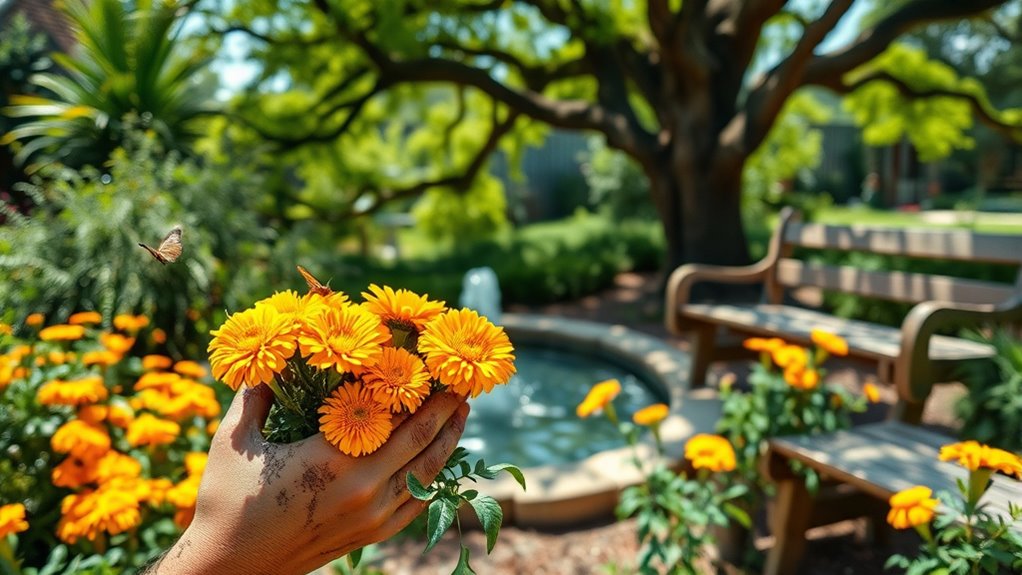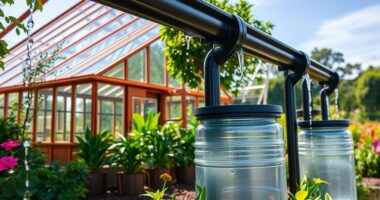Therapeutic gardening can truly enhance both mental and physical well-being. I've found that engaging with nature fosters emotional clarity and relaxation. Creating accessible gardens with diverse plant species supports everyone, while community involvement boosts social connections. Regular maintenance and sustainable practices keep gardens thriving. I've seen firsthand how gardening promotes mental health, reduces stress, and cultivates a real sense of accomplishment. Want to discover even more about these healing practices? Let's explore together.
Key Takeaways
- Incorporate sensory elements like diverse textures, colors, and scents to enhance emotional engagement and promote mental well-being.
- Design accessible garden spaces with raised beds and pathways to accommodate individuals with varying physical abilities.
- Utilize adaptive gardening tools to support participation and make gardening more enjoyable for everyone.
- Engage community members through collaborative gardening projects to foster social connections and a sense of belonging.
- Implement sustainable practices, such as composting and native planting, to promote long-term garden health and environmental benefits.
The Well-Gardened Mind: The Restorative Power of Nature
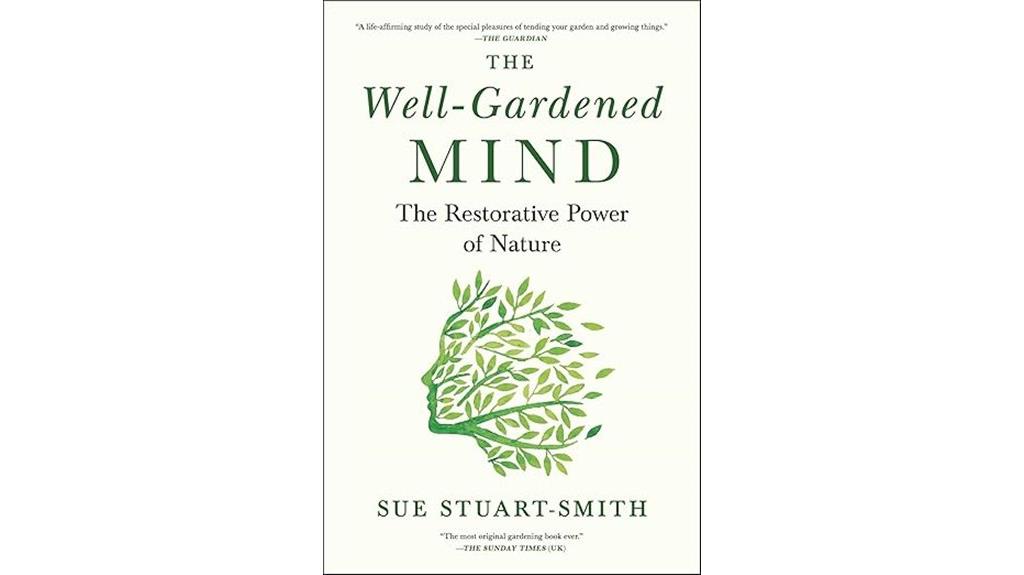
If you're someone seeking solace or a deeper connection with nature, "The Well-Gardened Mind" might just be what you need. I dove into this book right after an afternoon of gardening, and it resonated with me instantly. The author beautifully captures how gardening not only brings joy but also fosters resilience. His exploration of the health benefits, backed by real-life examples, showcases gardening's healing power for various communities. Beyond practical advice, he probes into philosophical themes that challenge how we see our relationship with nature. This book is a treasure for anyone wanting to nurture both mind and body through gardening.
Best For: Anyone seeking a deeper connection with nature and the mental health benefits of gardening.
Pros:
- Inspiring storytelling that resonates with both experienced and novice gardeners.
- Evidence-based insights on the health benefits of gardening for various communities, highlighting its restorative power.
- Philosophical exploration of our relationship with nature, encouraging readers to think beyond gardening as just a hobby.
Cons:
- Some readers may find the content simplistic if they are long-time gardeners looking for more depth.
- A few sections may feel technical, which could be challenging for readers seeking a more straightforward narrative.
- Varying reactions mean that not everyone will appreciate the balance of practical advice with philosophical insights.
Horticultural Therapy Methods: Connecting People and Plants in Health Care
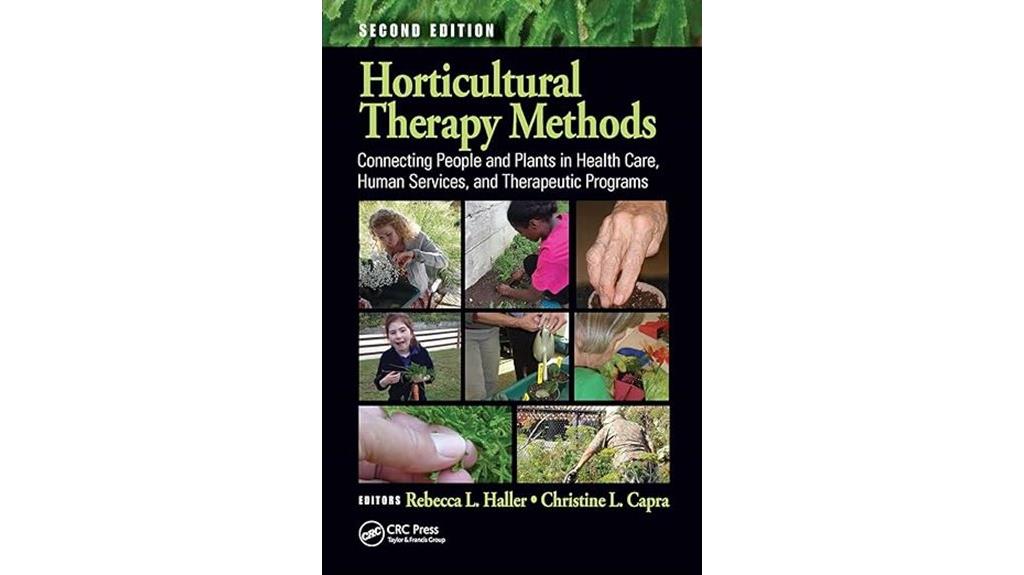
Horticultural therapy methods are an excellent choice for educators and health care professionals looking to enhance the well-being of their students or patients. I've always dreamed of working in this field, and as a social and emotional teacher, I see firsthand how incorporating nature can uplift struggling students. A recent book I read offers wonderful ideas for applying these methods in educational settings. Readers rave about its informative content, and I'm excited to implement its concepts in my practice. By sharing these strategies, I hope to connect more people to plants and promote overall health and well-being.
Best For: Educators and health care professionals seeking innovative methods to enhance student or patient well-being through nature-based activities.
Pros:
- Promotes emotional and social development by connecting individuals with nature.
- Provides practical strategies that can be easily implemented in educational and healthcare settings.
- Encourages collaboration and sharing of ideas among colleagues, fostering a supportive community.
Cons:
- Requires training and understanding of horticultural therapy principles for effective implementation.
- May require additional resources such as plants, tools, and space, which may not be readily available in all settings.
- Effectiveness can vary based on individual preferences and engagement with nature.
Gardening For Mind, Body and Soul Book
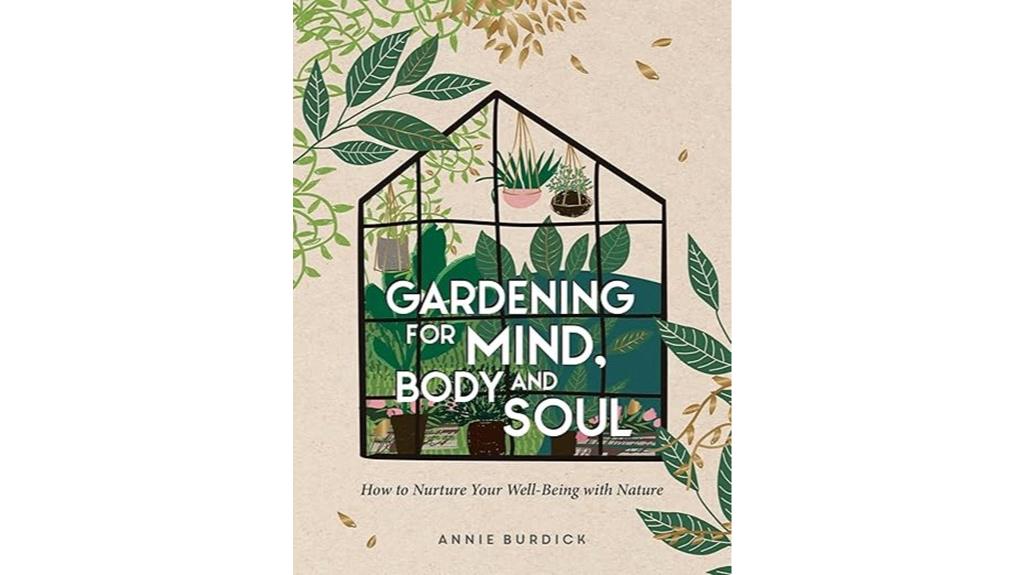
"Gardening For Mind, Body and Soul" is perfect for anyone seeking to enhance their well-being through the joys of gardening. I found this book incredibly enriching, as it beautifully connects gardening with mental health benefits. Witnessing growth in my garden has truly lifted my spirits, and I've gifted this book to my daughter, who's excited to grow vegetables in her polytunnel, and to a friend for their birthday. Both recipients were delighted, noting how informative and inspiring the ideas are. After seeing their enthusiasm, I'm definitely planning to grab a copy for myself to deepen my gardening journey.
Best For: Individuals looking to improve their mental well-being and gardening skills through informative and inspiring content.
Pros:
- Enhances mental health by promoting connection with nature and witnessing growth.
- Informative and inspiring ideas that cater to both novice and experienced gardeners.
- Versatile gift option for friends and family interested in gardening or personal well-being.
Cons:
- May not include advanced gardening techniques for experienced gardeners.
- Some readers may find the content too general for specific gardening needs.
- Limited focus on certain types of gardening, such as indoor or hydroponic gardening.
Designing, Planting and Using a Therapeutic Garden

For anyone looking to create a nurturing and accessible space, "Designing, Planting and Using a Therapeutic Garden" is an invaluable resource. This extensive guide is perfect for both beginners and seasoned pros in therapeutic horticulture. The beautiful visuals and organized layout make it easy to grasp essential concepts. It covers vital design elements while emphasizing accessibility, ensuring everyone can enjoy the benefits. I've found it particularly helpful for inspiring new ideas and practical strategies. With highly positive feedback from readers, it's clear this book can transform your gardening experience into a truly therapeutic journey for mind and body.
Best For: Individuals interested in therapeutic horticulture, including beginners and professionals looking to design accessible gardens.
Pros:
- Comprehensive content: Covers essential topics and design elements for therapeutic gardens.
- Visual appeal: Beautiful pictures and organized layout enhance understanding and engagement.
- Positive feedback: Highly recommended by readers for its inspiring ideas and practical guidance.
Cons:
- Limited advanced topics: May not delve deeply into advanced therapeutic horticulture techniques for experienced practitioners.
- Niche focus: Primarily targeted at therapeutic gardening, which may not appeal to general gardening enthusiasts.
- Accessibility issues: Some readers may find specific design recommendations less applicable to their unique environments or needs.
A Mystic Garden: Working with Soil, Attending to Soul
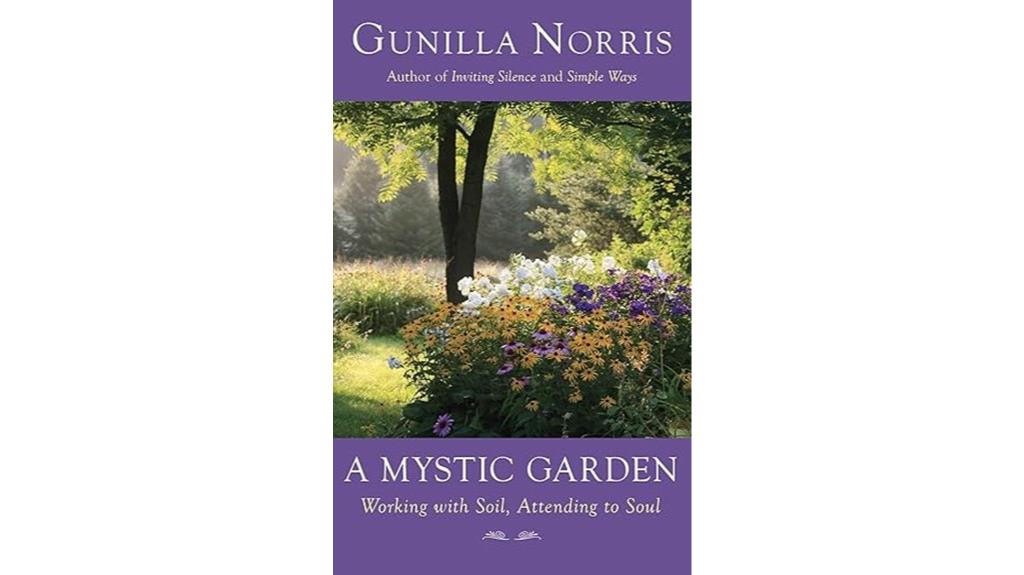
Embracing the tranquility of "A Mystic Garden" speaks volumes to anyone seeking solace amidst life's demands, especially those of us juggling the complexities of single parenting. This book offers profound emotional connections, providing clarity and relaxation when we need it most. I find its seasonal structure beautifully aligns with our journeys, allowing us to reflect and grow. The short reflections and poems make it accessible, inspiring me to plan my own garden with patience and intention. Gunilla Norris's metaphoric style resonates deeply, intertwining gardening with spiritual growth. It's a comforting read I've gifted to friends, spreading its healing messages.
Best For: Individuals seeking emotional solace and inspiration while navigating life's complexities, particularly single parents and gardening enthusiasts.
Pros:
- Provides emotional clarity and relaxation, making it a soothing read during challenging times.
- Organized by seasons, which enhances understanding and aligns with the natural rhythms of life.
- Accessible format with short reflections and poems, appealing even to those who may not be avid readers.
Cons:
- Some readers may find the metaphoric writing style less straightforward, potentially leading to confusion.
- The focus on gardening may not resonate with individuals who are not interested in horticulture.
- Limited depth on gardening techniques; seasoned gardeners may seek more practical guidance.
Premium Titanium Garden Pruning Shears

When you're looking for tools that make gardening more accessible, the Premium Titanium Garden Pruning Shears stand out, especially for those with hand difficulties like rheumatoid arthritis. I've found their ergonomic design truly comfortable, thanks to the non-slip, soft PVC coated handles. The sharp titanium blades effortlessly cut branches up to 3/4 inch in diameter, making tasks like deadheading and trimming a breeze. Plus, the robust locking mechanism guarantees safety. With an extra blade and spring included, these shears offer great value. Overall, they've become my go-to tool for various gardening tasks, enhancing my gardening experience considerably.
Best For: Individuals with hand difficulties, such as rheumatoid arthritis, who need ergonomic and efficient gardening tools.
Pros:
- Ergonomic design with non-slip, soft PVC coated handles for comfortable grip and reduced strain.
- Ultra-strong titanium blades that are sharp, rust, and corrosion-resistant, ensuring effective cutting.
- Includes extra blade and spring for enhanced longevity and value.
Cons:
- Some users may require additional hand strength for thicker stems.
- Noise during closure reported by some users due to the lack of rubber bumpers.
- Careful handling of the locking mechanism is needed to ensure safety.
The Profession and Practice of Horticultural Therapy
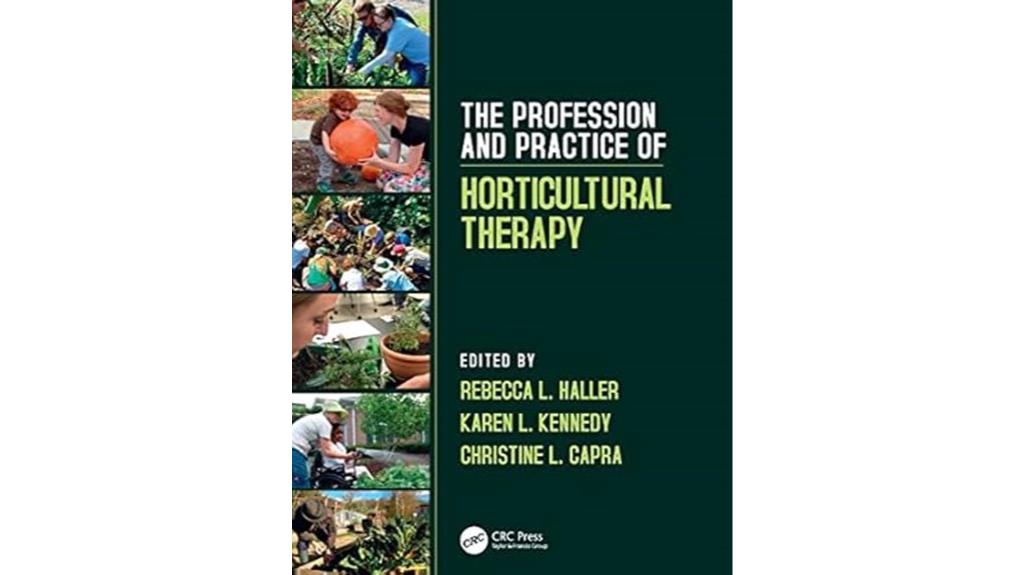
Horticultural therapy serves as an essential resource for those seeking to enhance their understanding and practice of therapeutic gardening. I found "The Profession and Practice of Horticultural Therapy" by Haller and Capra invaluable. This thorough guide dives into the history and theory behind the practice while providing practical insights for assessment and treatment planning. It highlights various settings like hospitals and community gardens, making it relatable. Although I recommend the paperback for usability, the case examples and ethical discussions enrich the learning experience. Whether you're pursuing a career or simply interested, this book is a must-have reference.
Best For: Individuals pursuing a career in horticultural therapy or those interested in therapeutic gardening practices.
Pros:
- Comprehensive guide covering history, theory, and practical aspects of horticultural therapy.
- Includes case examples and ethical discussions that enhance the learning experience.
- Applicable to various settings, such as hospitals, rehabilitation centers, and community gardens.
Cons:
- Kindle version suffers from formatting issues, making it difficult to read.
- Requires pinching and zooming, which can be frustrating for users.
- Mixed reviews regarding content value, with some readers finding usability lacking in the digital format.
Horticultural Therapy Methods Book
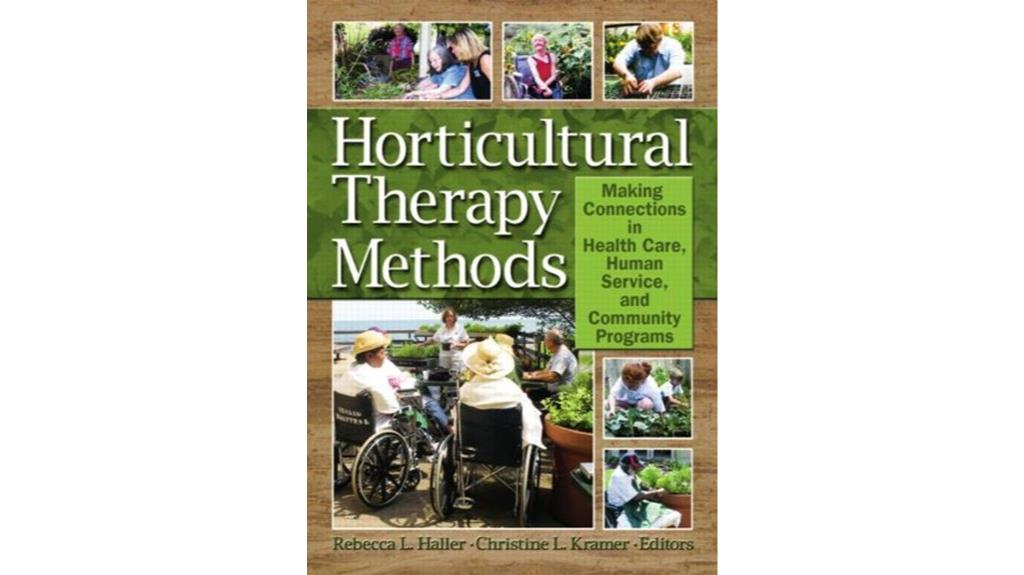
For anyone involved in facilitating gardening programs for individuals with disabilities, the "Horticultural Therapy Methods Book" stands out as an essential resource. It offers clear guidance for planning and executing effective horticultural therapy. I've found it particularly useful when working with developmental disabilities, as it provides concise strategies that make a difference. While some reviewers mention it can feel dry and prescriptive, I appreciate its depth and the way it fills gaps in the literature. Despite its limitations, I highly recommend this book for anyone looking to enhance their practice and foster patient engagement in therapeutic settings.
Best For: Individuals facilitating gardening programs for those with disabilities, particularly in therapeutic settings.
Pros:
- Offers clear and concise strategies for planning and executing horticultural therapy.
- Highly regarded for its utility in working with individuals with developmental disabilities.
- Fills gaps in the therapeutic horticulture literature, providing valuable insights for practitioners.
Cons:
- Some readers find the content dry and prescriptive, lacking engagement.
- Critiques highlight a focus on monitoring rather than co-designing treatment goals with patients.
- Limited variety in therapeutic horticulture literature may not align with all therapeutic philosophies.
The Therapeutic Power of Herbal Gardening
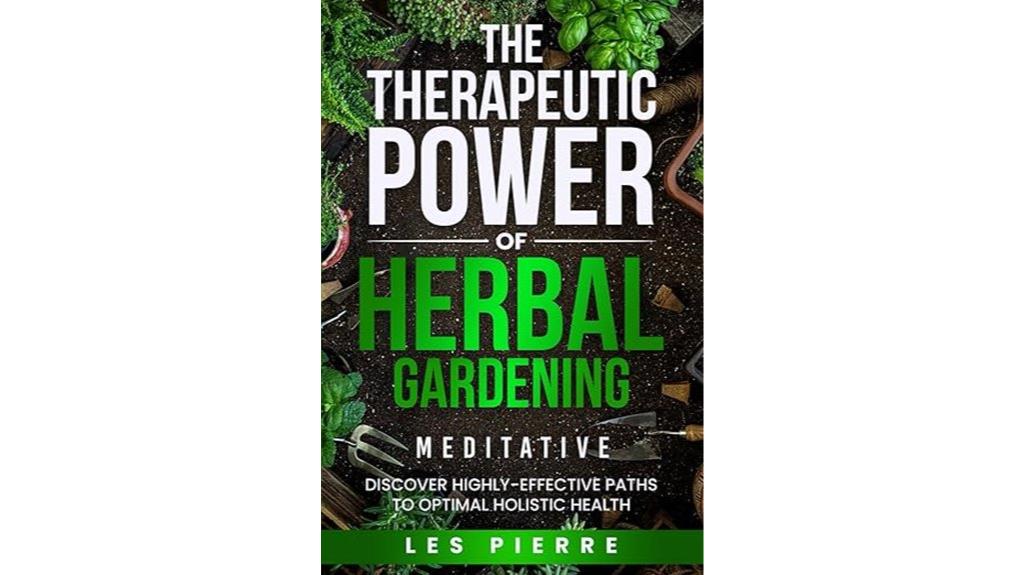
Herbal gardening offers a unique blend of creativity and healing, making "The Therapeutic Power of Herbal Gardening" an ideal choice for anyone seeking a deeper connection with nature and improved well-being. Les Pierre's book reveals how to cultivate a mindful relationship with plants, enhancing self-care and mental clarity. It provides practical guidance for designing therapeutic gardens while highlighting the medicinal properties of various herbs. Readers appreciate the clear instructions and inspiring visuals, finding it accessible even for beginners. By engaging with herbal gardening, I've experienced stress relief, boosted my immune system, and deepened my connection to the earth.
Best For: Individuals seeking to enhance their well-being through gardening and a deeper connection with nature.
Pros:
- Holistic Approach: Emphasizes the mind-body-spirit connection, promoting overall wellness.
- Accessible Guidance: Clear, step-by-step instructions make it suitable for beginners and experienced gardeners alike.
- Therapeutic Benefits: Encourages stress relief and improved mental health through gardening practices.
Cons:
- Limited Scope: Focuses primarily on herbs, which may not appeal to all gardening enthusiasts.
- Requires Commitment: Maintaining a garden may demand time and effort that some may find challenging.
- Potential Learning Curve: Beginners might need to invest additional time to fully grasp herbal properties and gardening techniques.
Mindful Gardening: Cultivating Serenity and Mental Clarity
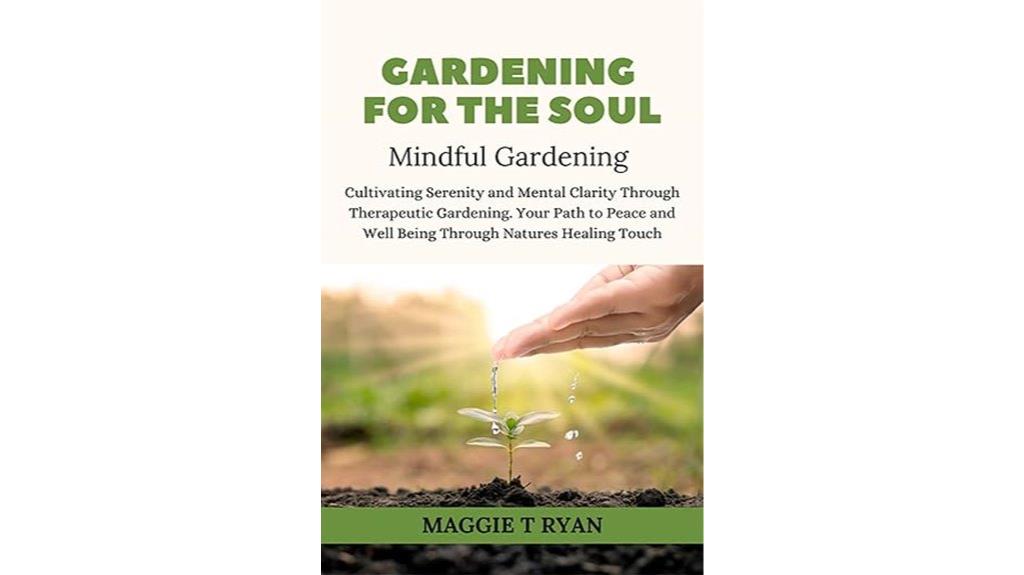
Gardening often feels like a sanctuary where I can escape the chaos of daily life, making it an ideal practice for anyone seeking tranquility and mental clarity. After my surgeries and moving to a new state, I longed to start fresh in my garden, feeling like a beginner all over again. Maggie Ryan's book, "Gardening for the Soul: Mindful Gardening," rekindled my passion for planting. Her insights guide me in embracing the therapeutic aspects of gardening, reminding me that engaging with nature fosters emotional wellbeing. This mindful approach not only heals but also enriches my connection to the world around me.
Best For: Individuals seeking tranquility, mental clarity, and a deeper connection to nature through gardening practices.
Pros:
- Therapeutic Benefits: Engaging with gardening helps reduce stress and improve mental health.
- Guidance for Beginners: The book offers valuable insights for those starting anew in unfamiliar gardening zones.
- Gift Potential: A thoughtful present for family or friends who appreciate nature and gardening.
Cons:
- Limited Audience: May not appeal to those who are not interested in gardening or nature.
- Time Commitment: Gardening requires a significant amount of time and effort, which may be a barrier for some.
- Climate Dependency: Success in gardening can heavily depend on local climate conditions, potentially limiting the effectiveness of the advice provided.
The Healing Garden: Herbal Plants for Health and Wellness
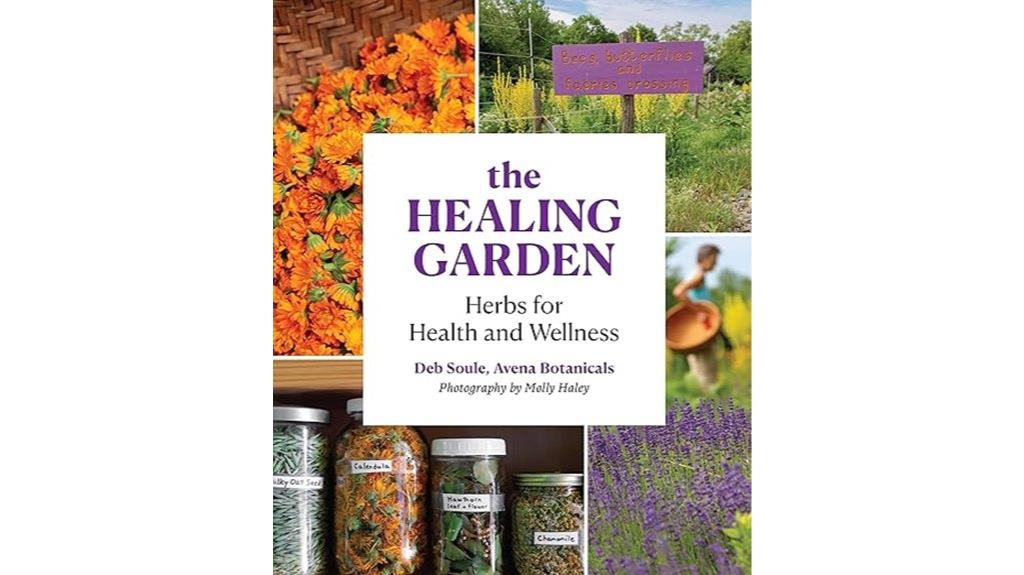
If you're looking to deepen your connection with nature while enhancing your health, "The Healing Garden: Herbal Plants for Health and Wellness" might just be what you need. This book, written by Deb Soule, beautifully honors her Grandmother Katherine's teachings, grounding me with its heartfelt content and stunning visuals. It's perfect for both beginner and experienced gardeners, offering clear descriptions and practical recipes for herbal remedies. While some readers may desire more extensive content, I found it inspiring and accessible. Check local stores or libraries for a copy—you won't regret exploring the world of herbalism!
Best For: This book is best for both beginner and experienced gardeners looking to explore herbalism and enhance their connection with nature.
Pros:
- Highly educational with heartfelt content that honors traditional teachings.
- Clear descriptions and practical recipes make it accessible for all skill levels.
- Beautiful visuals that inspire and encourage exploration of herbal plants.
Cons:
- Some readers desire more comprehensive content and practical applications.
- Limited usefulness reported by a few users who sought greater depth in the material.
- Customer service issues noted regarding refunds for mistaken purchases.
Growing with Gardening: A Twelve-month Guide for Therapy, Recreation, and Education
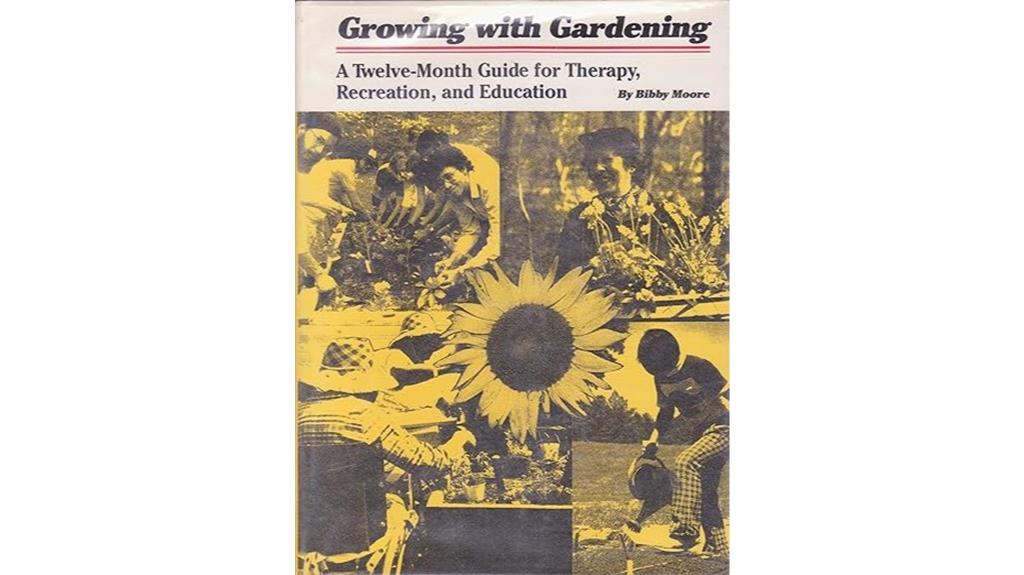
For Activity Directors in nursing homes and educators working with individuals with disabilities, "Growing with Gardening: A Twelve-month Guide for Therapy, Recreation, and Education" is an invaluable resource. This guide provides practical, step-by-step instructions for gardening tasks like planting and pruning, tailored for various abilities. I love how it includes accessible planter designs and budget-friendly supplies, making it easy to implement. The innovative ideas spark creativity and enhance engagement, transforming gardening into a therapeutic experience for everyone involved. Whether you're leading a group or facilitating individual sessions, this guide truly enriches the gardening journey for participants of all ages.
Best For: Activity Directors in nursing homes and educators working with individuals with disabilities who are seeking to enhance therapeutic gardening experiences.
Pros:
- Provides practical, step-by-step gardening instructions that cater to various abilities.
- Includes accessible planter designs and budget-friendly supply lists for easy implementation.
- Sparks creativity and engagement through innovative gardening-related projects.
Cons:
- May require additional resources or tools not mentioned in the guide for some activities.
- Limited focus on advanced gardening techniques that experienced gardeners may seek.
- Some users might find the budget-friendly options limiting if they wish to pursue more specialized gardening supplies.
Horticulture as Therapy
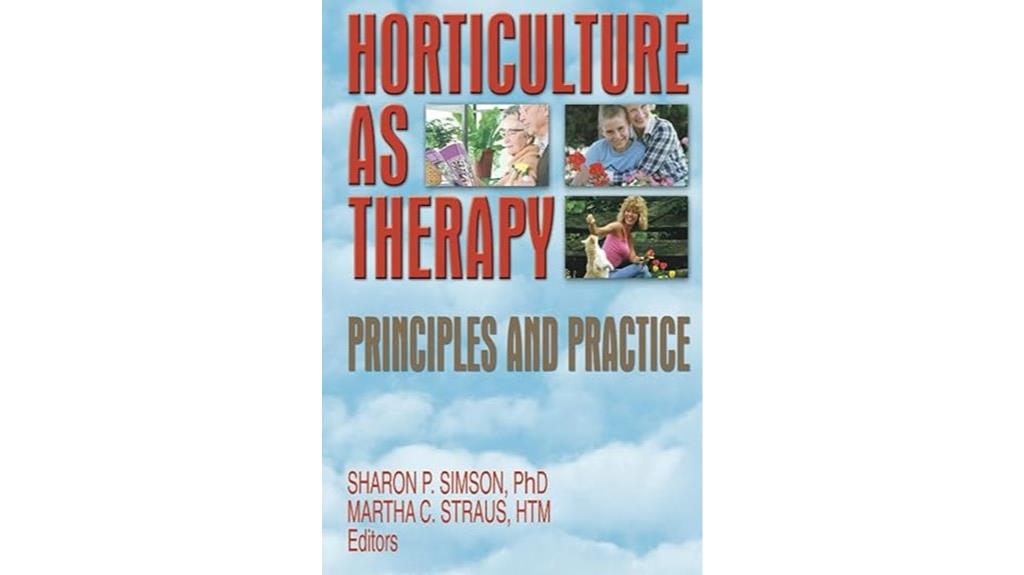
Horticultural therapy stands out as an invaluable resource for anyone interested in promoting health and well-being through gardening activities. I've found it particularly beneficial for diverse groups, including children and older adults, as it fosters connection and healing. This book offers a solid introduction and explores theories behind this practice, making it an excellent educational tool for students and professionals. While some chapters need updates, the insights are still relevant. Many readers, myself included, appreciate its depth and plan to revisit its content. Despite its physical condition, it remains a go-to resource for anyone delving into horticultural therapy.
Best For: Students, professionals, and individuals interested in horticultural therapy and its benefits for diverse client groups.
Pros:
- Valuable educational resource for students and faculty pursuing horticulture and therapeutic practices.
- Comprehensive introduction to horticultural therapy, covering essential theories and practices.
- Highly rated by readers for its informative content and depth, making it a useful reference tool.
Cons:
- Outdated content in some chapters, particularly those focused on specific client groups, which may limit its utility.
- Poor physical condition of the book, with several pages falling out, detracting from the reading experience.
- Some readers feel the book is not worth the investment due to its outdated information.
Factors to Consider When Choosing Therapeutic Gardening
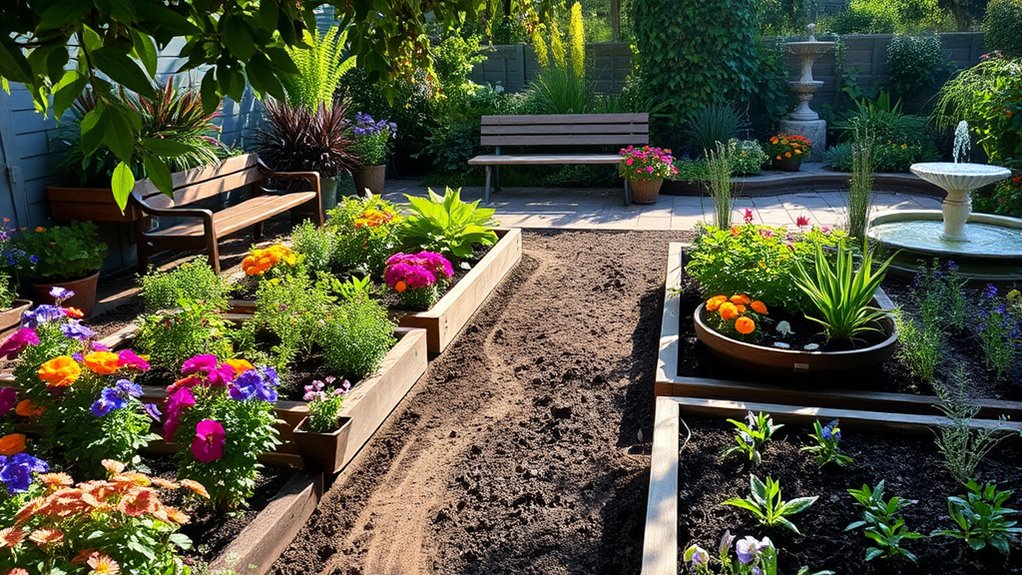
When I think about choosing therapeutic gardening, I consider several important factors. Accessibility and the right plant selection can really impact my experience, along with my specific therapeutic goals. Plus, being aware of environmental conditions and community involvement opportunities helps me create a more fulfilling gardening practice.
Accessibility and Inclusivity
Creating a therapeutic garden that welcomes everyone involves thoughtful consideration of accessibility and inclusivity. I focus on designing spaces with features like raised beds, wheelchair-accessible pathways, and adaptive tools to support individuals with varying abilities. I also think about sensory experiences by choosing plants with diverse textures, colors, and scents, making the garden engaging for all ages and backgrounds.
Incorporating seating areas and shaded spots enhances comfort, encouraging participation from those with mobility challenges or needing a break from the sun. Clear signage and tactile guides help individuals with visual impairments navigate the space, fostering independence. By engaging the community in the planning process, I guarantee the garden meets specific needs and preferences, creating a truly welcoming environment for everyone.
Plant Selection Considerations
Selecting the right plants for a therapeutic garden is essential, as it can greatly impact participants' experiences and well-being. I focus on sensory attributes like color, texture, and fragrance, which enhance emotional engagement. It's important to choose resilient, easy-care plants, especially for those facing physical or cognitive challenges. I love incorporating a variety of species—flowering plants, herbs, and vegetables—to provide diverse experiences and encourage sensory exploration. Considering seasonal growth patterns, I create a dynamic garden that offers new joys throughout the year. Finally, I opt for plants known for their therapeutic properties, like calming herbs or those with medicinal uses, to boost the health benefits of gardening. This thoughtful selection truly enriches the experience for everyone involved.
Therapeutic Goals and Outcomes
After carefully considering plant selection, I turn my attention to the therapeutic goals and outcomes of gardening. I aim to improve mental health by reducing stress, anxiety, and depression, which numerous studies have shown. My goals often include enhancing physical rehabilitation, improving social skills, and fostering a deeper connection with nature. This connection can lead to greater life satisfaction. I focus on specific outcomes, like developing fine motor skills and cognitive enhancement, while also boosting feelings of self-efficacy and empowerment. To measure effectiveness, I rely on qualitative feedback and quantitative metrics, such as mood improvements. By tailoring activities to individual needs and preferences, I greatly increase the likelihood of achieving these desired therapeutic outcomes.
Environmental Factors and Conditions
When considering therapeutic gardening, I always keep environmental factors and conditions in mind, as they can greatly influence the success of the garden and the overall experience. First, I assess sunlight availability; therapeutic gardens need at least 6-8 hours of direct sunlight each day for healthy plant growth. Next, I evaluate soil quality and drainage to guarantee it supports diverse plant life and prevents root rot. Accessibility is vital, so I incorporate raised beds and paths for those with mobility challenges. I also monitor local climate conditions, as they impact plant selection and gardening activities. Finally, I factor in natural elements like water features or wildlife habitats, which enhance the sensory experience and therapeutic benefits of the garden.
Community Involvement Opportunities
Creating a therapeutic garden isn't just about the plants and environment; community involvement plays a significant role too. When I engage local volunteers or organizations in my gardening projects, I notice how it enhances social connections and fosters a sense of belonging. This support is essential for mental well-being. Collaborative initiatives also provide valuable educational opportunities, allowing us to learn about horticulture, sustainability, and healthy eating together. I love seeing intergenerational interactions flourish in community gardens, bridging gaps between age groups through shared experiences. Plus, when community members take ownership of the garden, it empowers us all, boosting self-esteem and personal growth. Involving others truly enriches the therapeutic gardening experience for everyone.
Maintenance and Sustainability
Choosing the right practices for maintaining a therapeutic garden is essential for its success and sustainability. I've found that using sustainable methods, like native plants and organic practices, really enhances the garden's longevity. Establishing a regular maintenance schedule for weeding, pruning, and harvesting keeps the garden productive and engaging. Incorporating composting systems not only reduces waste but also enriches the soil, promoting healthy growth. Plus, using water-efficient irrigation techniques, like drip systems, conserves water while ensuring plants stay hydrated. Engaging participants in the maintenance process fosters a sense of ownership and responsibility, amplifying the therapeutic benefits of gardening. By focusing on these aspects, we can create a vibrant and sustainable space for healing.
Frequently Asked Questions
What Types of Plants Are Best for Therapeutic Gardening?
When it comes to therapeutic gardening, I've found that certain plants really shine. I love incorporating herbs like lavender and chamomile, as they offer calming scents and can be used in tea. Succulents are great too; they're low-maintenance and bring a sense of tranquility to my space. Flowers like sunflowers and marigolds brighten my mood. Whatever plants I choose, I always feel a deeper connection to nature, which truly enhances my well-being.
Can Therapeutic Gardening Be Done Indoors?
Absolutely, I've found that therapeutic gardening can be done indoors quite effectively. I've created my own little green sanctuary using potted plants, herbs, and even small flowers. Not only does it brighten up my space, but caring for them brings me a sense of peace. I love watching them grow and thrive, which really helps my mental well-being. So, if you've got the space, give indoor gardening a try! You won't regret it.
How Often Should I Tend to My Therapeutic Garden?
You might think tending to a garden takes too much time, but it doesn't have to be overwhelming. I usually spend about 30 minutes a few times a week in my therapeutic garden. This frequency keeps my plants healthy and gives me a chance to unwind. You can adjust based on your schedule and what works for you. Just remember, even a little time can make a big difference in your garden's wellbeing.
Is There a Specific Time of Year to Start Gardening?
I've found that the best time to start gardening really depends on what you want to grow. In my experience, spring is ideal for most plants since the weather warms up and the risk of frost decreases. I usually prep my garden in late winter, planning what I'll plant. However, I also love planting fall crops, which can thrive in cooler weather. So, I'd suggest considering your local climate and what you enjoy growing!
Can Children Participate in Therapeutic Gardening Activities?
Absolutely, children can participate in therapeutic gardening activities! I've found that involving kids in gardening not only teaches them about nature but also fosters responsibility and creativity. They love digging, planting seeds, and watching their efforts bloom. Plus, it's a great way for them to connect with their emotions and the environment. Just be sure to supervise and choose age-appropriate tasks to keep it fun and safe for everyone involved!
Conclusion
As I cultivate my garden, I find that each seed I plant symbolizes hope and renewal. Just like the flowers that bloom after a long winter, our minds and bodies can flourish through the healing embrace of nature. Embracing therapeutic gardening isn't just about growing plants; it's about nurturing our souls. So, let's dig deep, tend to our inner landscapes, and watch as we blossom into our best selves, one garden at a time.
